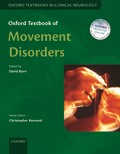 Oxford Textbook of Movement Disorders
Oxford Textbook of Movement Disorders
Contents
-
-
-
-
-
-
-
-
-
-
-
-
-
-
-
-
-
-
-
-
-
-
-
-
-
-
-
-
-
-
-
-
Summary Summary
-
Paraneoplastic syndromes Paraneoplastic syndromes
-
Paraneoplastic ataxia Paraneoplastic ataxia
-
Paraneoplastic stiff person syndrome Paraneoplastic stiff person syndrome
-
Paraneoplastic opsoclonus–myoclonus syndrome Paraneoplastic opsoclonus–myoclonus syndrome
-
Other paraneoplastic movement disorders Other paraneoplastic movement disorders
-
-
Autoimmune diseases Autoimmune diseases
-
Autoimmune thyroid disease Autoimmune thyroid disease
-
Coeliac disease Coeliac disease
-
Systemic lupus erythematosus Systemic lupus erythematosus
-
Antiphospholipid antibody syndrome Antiphospholipid antibody syndrome
-
Sjögren’s syndrome Sjögren’s syndrome
-
Behçet’s disease Behçet’s disease
-
-
Sarcoidosis Sarcoidosis
-
Endocrine and metabolic disorders Endocrine and metabolic disorders
-
Thyroid disease Thyroid disease
-
Parathyroid disease Parathyroid disease
-
Diabetes mellitus Diabetes mellitus
-
Renal disease Renal disease
-
Liver disease Liver disease
-
-
Toxic and nutritional deficiencies Toxic and nutritional deficiencies
-
Vitamin E malabsorption Vitamin E malabsorption
-
Ethanol Ethanol
-
-
Infectious diseases Infectious diseases
-
Viruses Viruses
-
Bacteria Bacteria
-
Antibody-mediated disorders Antibody-mediated disorders
-
Direct mechanisms Direct mechanisms
-
-
Parasitic infections Parasitic infections
-
-
Conclusion Conclusion
-
Top clinical tips Top clinical tips
-
References References
-
-
-
-
-
29 Systemic Disease and Movement Disorders
Get access-
Published:October 2013
Cite
Abstract
Systemic illness is often complicated by the development of movement disorders, and the spectrum of movement disorders occurring in systemic diseases is as diverse as the spectrum of diseases eliciting them. While movement disorders often develop in patients with a known systemic illness, they can sometimes be the presenting feature of a systemic disease (1). Although pregnancy is not considered an “illness” there are many movement disorders associated with this condition(2). Recognition and treatment of the underlying condition or a systemic disorder is essential for the optimal management of associated abnormal movements. Therefore, when evaluating patients with movement disorders, clinicians should carefully consider all medical historical details, associated symptoms and signs, and risk factors for systemic diseases as these may provide important clues to the underlying aetiology of both the systemic and the associated movement disorders. The information presented in this chapter should serve as a guide not only to movement disorder clinicians but also to general and primary care physicians. Recognizing the movement disorder phenomenology is the first step that eventually leads to the aetiologic diagnosis.
This chapter reviews movement disorders occurring in conjunction with several broad categories of systemic disease, including paraneoplastic, autoimmune, endocrine, metabolic, nutritional, and infectious diseases.
Sign in
Personal account
- Sign in with email/username & password
- Get email alerts
- Save searches
- Purchase content
- Activate your purchase/trial code
- Add your ORCID iD
Purchase
Our books are available by subscription or purchase to libraries and institutions.
Purchasing information| Month: | Total Views: |
|---|---|
| October 2022 | 1 |
| February 2023 | 2 |
| April 2023 | 2 |
| May 2023 | 1 |
| August 2023 | 1 |
| December 2023 | 2 |
| March 2024 | 1 |
| June 2024 | 2 |
| October 2024 | 1 |
| November 2024 | 2 |
| December 2024 | 1 |
| January 2025 | 2 |
| March 2025 | 5 |
Get help with access
Institutional access
Access to content on Oxford Academic is often provided through institutional subscriptions and purchases. If you are a member of an institution with an active account, you may be able to access content in one of the following ways:
IP based access
Typically, access is provided across an institutional network to a range of IP addresses. This authentication occurs automatically, and it is not possible to sign out of an IP authenticated account.
Sign in through your institution
Choose this option to get remote access when outside your institution. Shibboleth/Open Athens technology is used to provide single sign-on between your institution’s website and Oxford Academic.
If your institution is not listed or you cannot sign in to your institution’s website, please contact your librarian or administrator.
Sign in with a library card
Enter your library card number to sign in. If you cannot sign in, please contact your librarian.
Society Members
Society member access to a journal is achieved in one of the following ways:
Sign in through society site
Many societies offer single sign-on between the society website and Oxford Academic. If you see ‘Sign in through society site’ in the sign in pane within a journal:
If you do not have a society account or have forgotten your username or password, please contact your society.
Sign in using a personal account
Some societies use Oxford Academic personal accounts to provide access to their members. See below.
Personal account
A personal account can be used to get email alerts, save searches, purchase content, and activate subscriptions.
Some societies use Oxford Academic personal accounts to provide access to their members.
Viewing your signed in accounts
Click the account icon in the top right to:
Signed in but can't access content
Oxford Academic is home to a wide variety of products. The institutional subscription may not cover the content that you are trying to access. If you believe you should have access to that content, please contact your librarian.
Institutional account management
For librarians and administrators, your personal account also provides access to institutional account management. Here you will find options to view and activate subscriptions, manage institutional settings and access options, access usage statistics, and more.